
Original Link: https://www.anandtech.com/show/2288
Biostar TF560 A2+: Overclocking NVIDIA's new nForce 560
by Gary Key on August 2, 2007 12:15 AM EST- Posted in
- Motherboards
We have to wonder what is going on at NVIDIA these days. Of all the companies we have dealt with over the years, they seemed to always be the most aggressive when promoting or launching a new product. As of late, we have seen a kinder, gentler NVIDIA when it comes to the marketing of new products. Who knows, maybe Jen-Hsun Huang is out searching for his thousand points of light or life in San Jose is just a little more relaxed than it used to be a few months ago?
Whatever is happening over at Mean Green (Ed: tm?), we are starting to worry that we might miss a really interesting new product launch with the current soft sell approach. Don't get us wrong, we would rather have laid back product announcements and launch activities than having a marching band, balloons, and a three ring circus show up in our offices any day. However, a little tap on the head or nudge in the right direction every once in awhile when an interesting product shows up would be nice.
We almost missed the product we are previewing today. Sure, we saw the press announcements for the nF560 chipset back at Computex and even noticed a couple of early production samples in the various supplier booths. However, the first products based on the nF560 just sort of showed up at our doorsteps a couple of weeks ago without any fanfare. We thought maybe it was just a product update or replacement for the nF520 (another silent introduction) but it turns out to be the true replacement for the nF550.
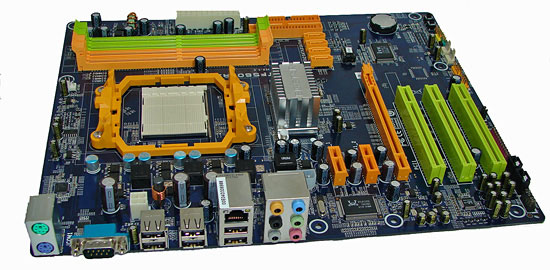
We would love to show you a block diagram of the nForce 560 chipset but it is not available yet. However, the actual specification for the nForce 560 chipset is available from NVIDIA. The short story is that the nForce 560 is designed for the mainstream market with a motherboard price target in the $70~$80 range. The nForce 560 offers an expanded feature set over the nForce 520 and 550, including GPU Optimizations for the GeForce 7300GT, 7600GS and 8500GT cards, FirstPacket network technology, and the addition of RAID 5 capability. In terms of I/O features, the nF560 offers four SATA 3Gb/s ports, two PATA ports, one GigE port, ten USB 2.0, and up to four PCI Express slots (1x16,3x1).
The nForce 560 technically offers one less PCIe lane than the nF550, and one less PCIe link; however, it makes up for this by being a single chip solution - one less chip to worry about cooling. While the nForce 520 and 560 officially support the upcoming AM2+ processors, they will not provide HyperTransport 3.0 or split power-plane capabilities.
The nForce 560 has been in the market for about a month now and is currently featured on the Biostar TF560 A2+ motherboard that we are previewing today. (Don't let the name confuse you: while the board supports AM2+ CPUs - like many AM2 boards will after a BIOS update - it is still a standard AM2 platform.) Our article will concentrate primarily on the overclocking capabilities of the board with the AMD X2 BE-2300 and Athlon 64 X2 3800+ processors. NVIDIA and Biostar just provided a new performance BIOS update along with new drivers that include the GPU optimizations. We will provide full test results and a features recap in an upcoming AM2 article.
From a general performance viewpoint, this particular chipset and board combination offer performance levels that are a little better than current NVIDIA 7050 and AMD 690G offerings. On the higher end, this board/chipset are typically equal to or slightly under the nF590/570 SLI boards. Let's take a quick look at the overclocking capabilities of the Biostar TF560 A2+ now.
AM2 Overclocking
| Biostar TF560 A2+ Overclocking Testbed |
|
| Processor | AMD X2 BE-2300, (1.9GHz, 2x512KB Cache) AMD Athlon 64 X2 3800+, (2.0GHz, 2x512KB Cache) |
| CPU Voltage | B-2300 1.40V (default 1.230V) X2 3800+ 1.45 (default 1.35V) |
| Cooling | Retail Air Cooling |
| Power Supply | Seasonic S12 II 380W |
| Memory | OCZ Reaper HPC PC2-6400 (2x1GB) |
| Video Cards | 1 x MSI 8800GTX |
| Hard Drive | Western Digital 150GB 10,000RPM SATA 16MB Buffer |
| Case | Cooler Master CM Stacker 830 |
| Maximum CPU OC | B-2300 - 333x9 (4-4-4-12, 1000MHz, 2.15V), CPU 1.408V 3003MHz (+58% CPU, +67% FSB) X2 3800+ - 300x10 (4-4-4-12, 1000MHz, 2.15V), CPU 1.450V 3003MHz (+50% CPU, +50% FSB) |
| . | |
X BE-2300 - Stock - 200x9.5
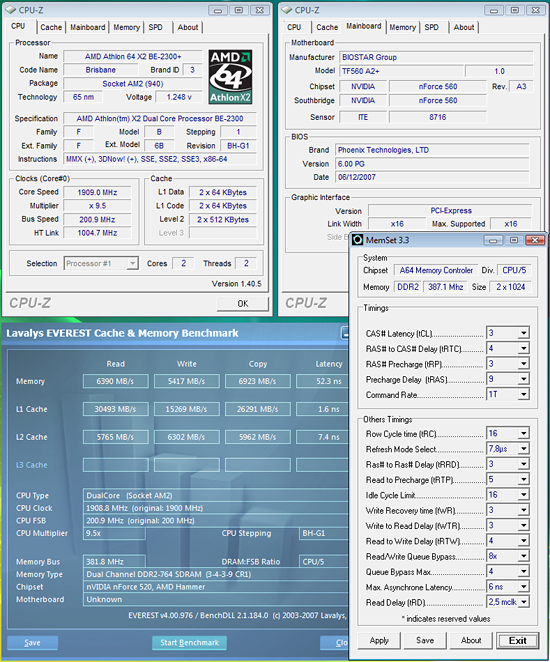 |
| Click to enlarge |
X2 BE-2300 - OC - 333x9
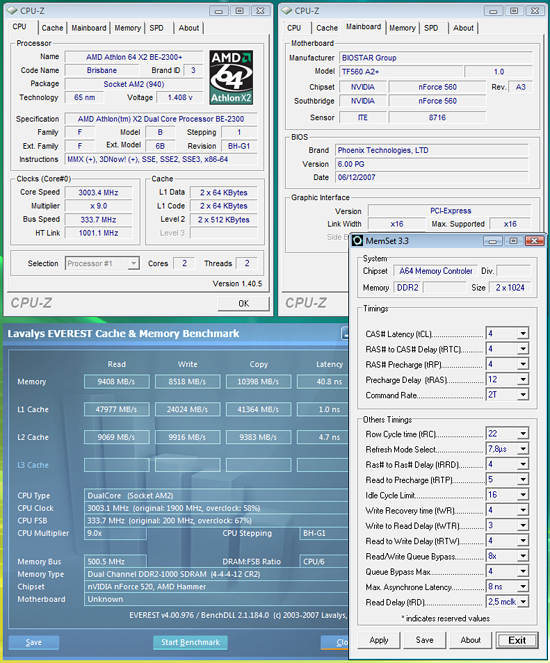 |
| Click to enlarge |
Our BE-2300 was able to reach a final setting of 333x9 with the stock cooler. CPU voltage had to be increased to 1.408V, chipset voltage to 1.300V, and memory to 2.15V in order to maintain full stability throughout our benchmark testing that included 24 hours of dual Prime95. We just received a new performance 0801 BIOS that allows us to reduce CPU voltage to 1.37V with the chipset voltage increased to 1.325V for the same settings. We found during testing that keeping tRC settings to 22 or less allowed us to run fairly aggressive CAS and tRAS timings with our OCZ HPC memory at both stock and overclocked settings. We were able to pass all benchmarks except for Quake 4 with tRAS set at 10 and tRC at 19 when overclocking.
X2 BE-2300 - Max OC - 350x9
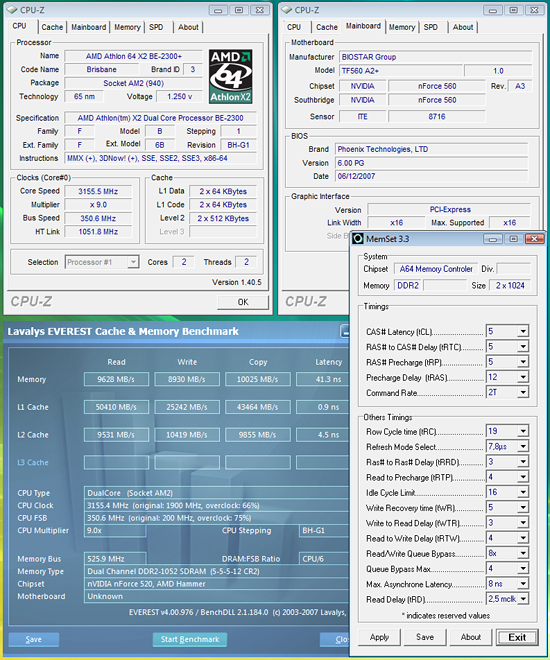 |
| Click to enlarge |
We turned our stock cooler in for a Tuniq 120, increased chipset voltage to 1.325V, and CPU voltage to 1.450V to reach a final 350HTT setting that was extremely stable during testing. Of note, our processor will actually do 3258MHz (362x9) on our ASUS CrossHair board but any HTT settings above 350 resulted in benchmark errors on our TF560 sample. The board would POST and enter Vista 64 at 365HTT but was not stable in most benchmarks or stability tests.
X2 3800+ - Stock - 200x10
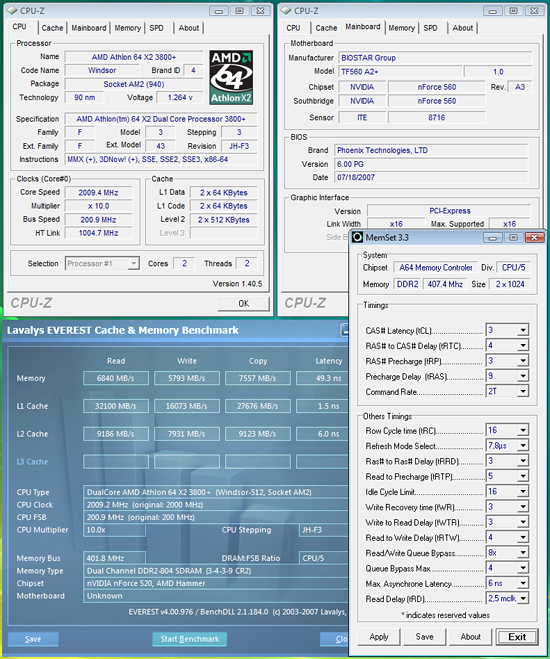 |
| Click to enlarge |
X2 3800+ - OC - 300x10
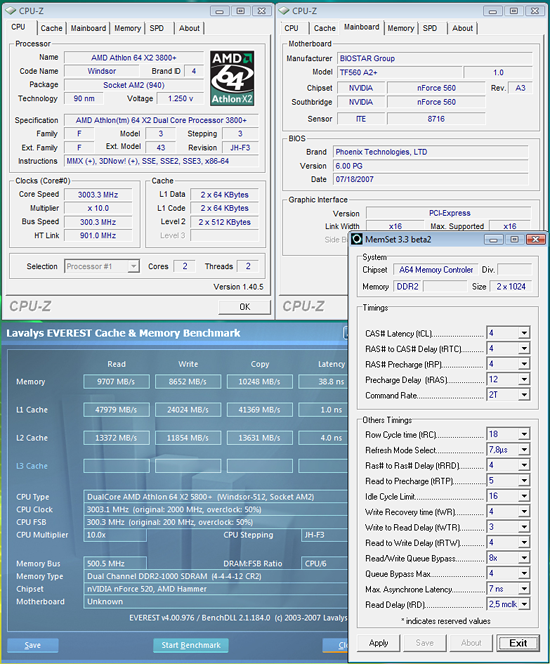 |
| Click to enlarge |
Although the Windsor based X2 3800+ is being phased out, the chips are still plentiful and priced at an incredible bargain of $65. We received the new F3 stepping but unfortunately we have a CCBVF 0706 lot number that did not afford us the same overclocking results we are seeing in lot numbers of CCB8F 0715 and beyond now. We just received our first CCB8F 0715 and it has already clocked to 3.4GHz on 1.475V. We will have full test results with this particular CPU in our next overclocking article.
In the meantime, our current X2 3800+ is the runt of the liter and would not even POST past 310x10. It did not matter what clock multiplier we utilized or how much voltage was pumped through this particular sample; we always ended up around 3GHz as its stable limit. With that in mind, we determined a final setting of 300x10 with memory set at DDR2-1000 offered the best overall performance. Our final CPU voltage was at 1.450V, chipset at 1.300V, and memory at 2.15V.
Test Setup
| Standard Test Bed Vista Ultimate 64-Bit Test Configuration |
|
| Processor | Intel E2160, (1.8GHz, 1MB Unified Cache) AMD Athlon 64 X2 6000+, (3.00GHz, 2x1MB Cache) AMD X2 BE-2300, (1.9GHz, 2x512KB Cache) AMD Athlon 64 X2 3800+, (2.00GHz, 2x512KB Cache) |
| RAM | OCZ Reaper HPC PC2-6400 |
| Hard Drive | Western Digital 150GB 10,000RPM SATA 16MB Buffer |
| System Platform Drivers | AMD 7.7 NVIDIA 15.01 |
| Video Cards | 1 x MSI 8800GTX |
| Video Drivers | 163.11 |
| CPU Cooling | Retail Stock Cooler |
| Power Supply | SeaSonic S12 II 380W |
| Optical Drives | Plextor PX-760A, Plextor PX-B900A |
| Case | Cooler Master CM Stacker 830 |
| Motherboards | Biostar TF560 A2+ - (nF560, AM2) BIOS 0612 EVGA 122-CK-NF66-T1 - (nF650i Ultra, 775) BIOS P03 Biostar TF7050-M2 - (NV7050, AM2) BIOS 0716 Jetway M2A692-GHG - (AMD 690G, AM2) BIOS A07 |
| Operating System | Windows Vista Ultimate 64-Bit |
| . | |
Test conditions were maintained the same, as much as possible, over the platforms tested. Our game tests were run at settings of 1280x1024 HQ with an 8800GTX to ensure our GPU was not a bottleneck during testing. We selected the AMD Athlon 64 X2 3800+, AMD X2 BE-2300, and the Intel E2160 processors as our processor choices as they represent great bargains at this moment along with a similar cost. Our motherboard choices for each chipset selected were based on comparisons of performance and similar cost. All results are reported in our charts and color-coded for easier identification of results.
We utilize new drive images on each board in order to minimize any potential driver conflicts. Our 3DMark results are generated utilizing the standard benchmark resolution for each program. We run each benchmark five times, throw out the two low and high scores, and report the remaining score. All results are run at stock speeds for this article with optimized memory timings.
Our choice of software applications to test is based on programs that enjoy widespread use and produce repeatable and consistent results during testing. Microsoft Vista has thrown a monkey wrench into testing as the aggressive nature of the operating system to constantly optimize application loading and retrieval from memory or the storage system presents some interesting obstacles. This along with the lack of driver maturity will continue to present problems in the near future with benchmark selections.
Our normal process is to change our power settings to performance, delete the contents of the prefetch folder, and then reboot after each benchmark run. This is a lengthy process but it results in consistency over the course of benchmark testing. All applications are run with administer privileges.
Note that for overclocking, all of the test CPUs topped out at between 3.0 and 3.2 GHz using stock cooling. We decided to normalize the speeds for direct clock-for-clock comparisons to 3.0 GHz, though we will also include results for the BE-2300 running at 3.15GHz. The X2 3800+ might have been able to squeeze out a bit more, but it didn't seem worth the effort, and the E2160 could get another ~80 MHz. With a Tuniq 120 and additional voltages, overclocking results would be a bit better, but using a $65 heatsink for a $150 setup didn't seem to make a lot of sense.
On a side note, the new performance BIOS releases from Biostar and Jetway for their respective NV7050 and AMD 690G equipped boards allowed us to match the HTT 333 setting for our BE-2300 overclocked test results today. We kept the memory settings the same as our nForce 560 board in order to show consistent results between chipsets. Our Jetway 690G board had the ability to run slightly tighter timings and an HT Link speed of 1600. We reached a maximum HTT setting of 342 on this board. In contrast, it was everything we could do to get our Biostar 7050 board stable at HTT 333 and until the 0716 BIOS release the board refused to POST past HTT 310. The maximum stable HTT setting reached was 335 with our BE-2300 and 306 with the X2 3800+.
Synthetic Graphics Performance
The 3DMark series of benchmarks developed and provided by Futuremark are among the most widely used tools for benchmark reporting and comparisons. Although the benchmarks are very useful for providing apples-to-apples comparisons across a broad array of GPU and CPU configurations they are not a substitute for actual application and gaming benchmarks. In this sense we consider the 3DMark benchmarks to be purely synthetic in nature but still very valuable for providing consistent measurements of performance.
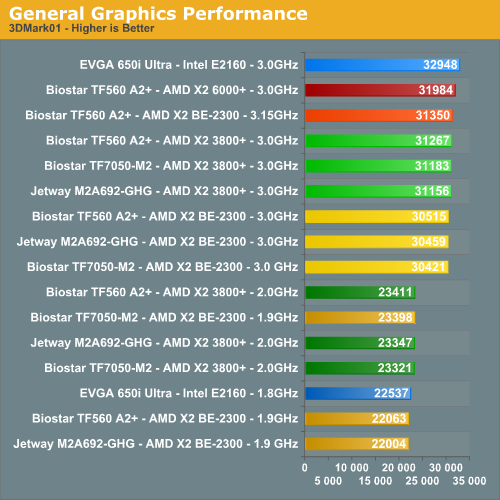
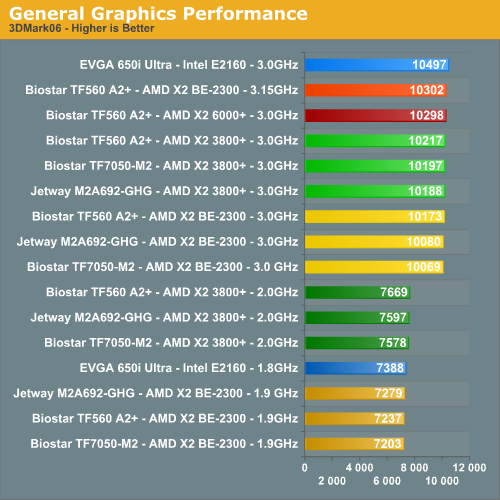
In our 3DMark06 test, our budget level processors are bunched together with a 6.5% spread between the three at stock settings. As expected the X2 3800+ edges out the E2160 and BE-2300 at stock settings in this CPU intensive benchmark but the Intel Core architecture comes alive in our first overclocking result. The spread is only 4.3% at the top with our latency deprived BE-2300 needing an additional overclock to 3.15GHz to overtake our X2 6000+ reference CPU. The BE-2300 has a performance increase of 38% when overclocked while the X2 3800+ improves by 33%. That's not bad for either CPU, considering that when combined with the Biostar TF560 A2+ board they still cost less than the X2 6000+ CPU.
In the more memory/CPU throughput sensitive 3DMark01 benchmark we see the same pattern at stock settings. The spread from top to bottom is 6.4% at stock but increases to 8.3% during overclocking. However, the differences in performance are not really noticeable in either 3DMark application unless you are looking for higher benchmark scores. The BE-2300 has an overclocking performance increase of 40% while the X2 3800+ only improves by 33%, mainly due to its lower HTT setting.
Looking at the three AM2 motherboards/chipsets, all of the CPU results tend to be clustered closely together with one exception. The BE-2300 in the nF7050 board outperforms the other two chipsets by 6% in 3DMark01. It appears that the BIOS on that board may be somewhat better tuned for the Brisbane core, though when we asked for more details we couldn't get a straight answer from any of the involved parties.
General System Performance
The PCMark05 benchmark developed and provided by Futuremark was designed for determining overall system performance for the typical home computing user. This tool provides both system and component level benchmarking results utilizing subsets of real world applications or programs. This benchmark is useful for providing comparative results across a broad array of Graphics, CPU, Hard Disk, and Memory configurations along with multithreading results. In this sense we consider the PCMark benchmark to be both synthetic and real world in nature, and it again provides for consistency in our benchmark results.
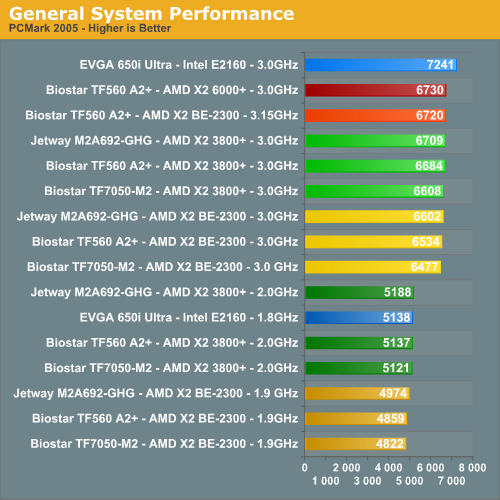
The performance spread in the stock score is 7.6% and 11.8% when overclocked, although in individual areas the differences between the CPUs may be more or less pronounced. In fact, it was in the first and third multitasking tests where our BE-2300 trailed our other solutions in both stock and overclocked settings. This is due in part to increased latencies in the L2 cache and the reduction in memory speed when compared to our other two budget CPUs. The BE-2300 has a performance increase of 34% while the X2 3800+ improves by 30% when overclocked; meanwhile, the E2160 improves by 41% with overclocking.
All three AM2 boards are clustered within about 1.5% of each other (about the margin of error in PCMark05), although the spread is slightly higher at 3% with the stock Brisbane core. This time, the 690G Jetway board ends up being the fastest of the three AM2 options, while the nF7050 finishes in third place - not that anyone would really notice a 1% difference in practice outside of running benchmarks.
General System Performance
The PC WorldBench 6.0 test suite developed and provided by PCWorld is designed for determining overall system performance for the home office user. This tool provides results for ten different real world applications that range from Adobe Photoshop to AutoDesk 3ds Max. This benchmark is useful for providing comparative results across a broad array of Graphics, CPU, Hard Disk, and Memory configurations. We chose a subset of this package that represents applications more commonly used in the home environment.
Adobe Photoshop CS2
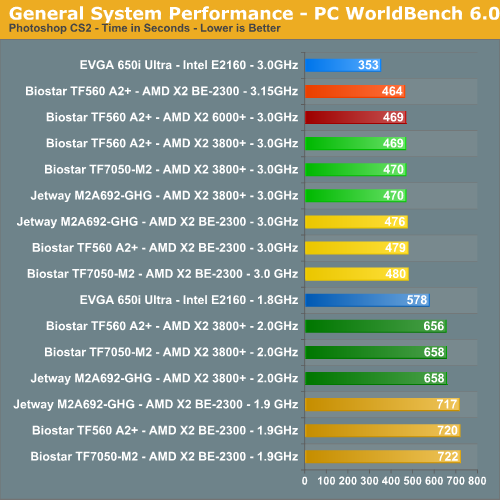
Since the introduction of the Intel Core 2 Duo architecture, Intel has enjoyed a significant lead in this particular benchmark. The E2160 is 13% faster at stock than the 3800+ and 33% faster when overclocked. Our overclocked AM2 budget processors perform roughly equal to our reference X2 6000+. The BE-2300 has a performance increase of 51% when overclocked while the X2 3800+ improves by 40% and the E2160 ends up 64% faster - almost perfectly linear performance scaling with clock speed.
Windows Media Encoder 9.0
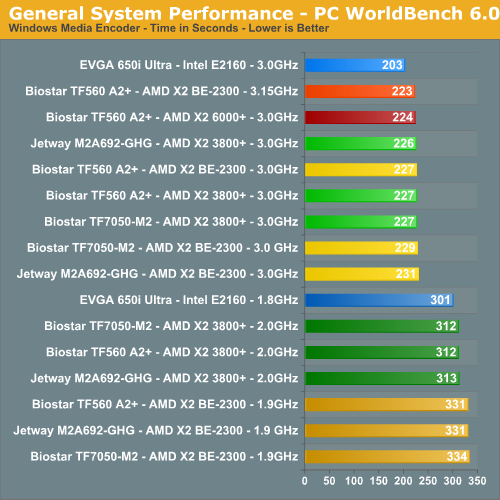
Once again, our overclocked AM2 budget processors perform the same as our reference X2 6000+ while the E2160 leads the grouping, although the margin of victory is much smaller in this test. Like Photoshop, WME tends to favor the Core 2 architecture. The BE-2300 has a performance increase of 32% while the X2 3800+ improves by 28% when overclocked. The E2160 shows a 48% improvement when overclocked, scoring 10% faster than the next closest competitor versus only 3.6% faster at stock speeds.
WinZip 10.0
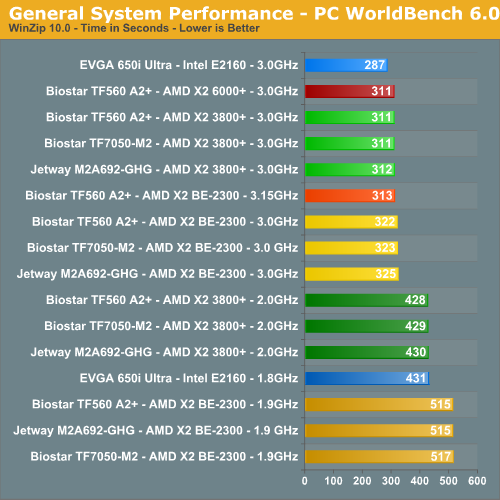
In our final benchmark that is generally CPU throughput and memory latency sensitive, we see the BE-2300 has a performance increase of 60% while the X2 3800+ improves by 38% when overclocked. The E2160 improves by 50% with overclocking. Based on CPU speed alone, our two budget AM2 processors are once again equal with our X2 6000+. There's nothing surprising there, though the fact that the increased HTT speeds of our budget processors overcame the L2 cache advantage of the 6000+ in our application tests is at least somewhat interesting. The E2160 again takes top honors among the overclocked budget CPUs, scoring 8.4% faster than the others; at stock speed it's roughly the same performance as the 3800+.
In a quick recap of the PC WorldBench results, the three AM2 boards all more or less tie when equipped with the same CPU. There are minor variations, but nothing statistically significant.
Gaming Performance
Our limited look at gaming performance consists of Prey and Battlefield 2. These two particular titles are both CPU throughput and memory latency sensitive when utilizing a GPU such as our MSI 8800GTX. We ran benchmarks with our standard 1280x1024 resolution set to High Quality mode. Given the number of users that run 19" LCDs these days, 1280x1024 represents one of the most commonly used resolutions and will still keep these two particular titles from becoming GPU bound.
Prey
Prey offers some superb action sequences, unique weapons and characters, and is a visually stunning game at times. It still requires a very good GPU to run it with all of the eye candy turned on. We set all graphic settings to their maximum except for AA/AF and utilize a custom timedemo that takes place during one of the more action oriented sequences.
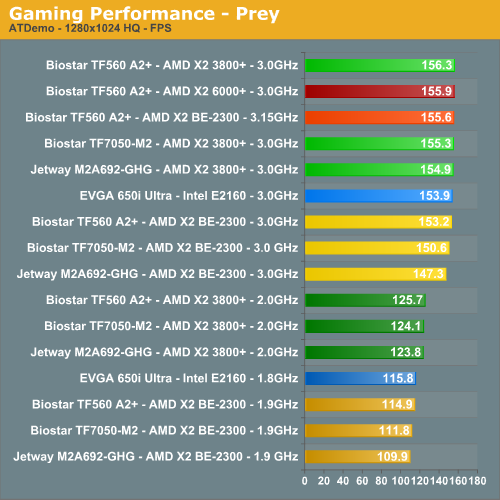
Battlefield 2
This benchmark is performed using DICE's built-in demo playback functionality with additional capture capabilities designed in house. When using the built-in demo playback features of BF2, frames rendered during the loading screen are counted in the benchmark. In order to get a real idea of performance, we use the instantaneous frame time and frames per second data generated from our benchmark run. We discard the data collected during the loading screen and calculate a result that represents actual game play.
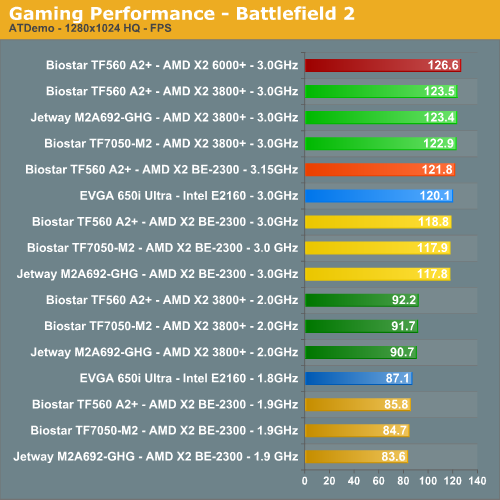
Gaming Summary
In a switch from our application benchmarks, we see our AM2 processors performing very well against the Intel E2160 in the gaming benchmarks from both a stock and overclocked performance perspective. It appears that for this particular task, the lack of L2 cache finally catches up with the Core 2 E2160. In Prey, the BE-2300 has a performance increase of 39% while the X2 3800+ improves by 26% when overclocked, and the E2160 improves by 33%. Battlefield 2 experiences similar gains with the BE-2300 being 42% faster and the X2 3800+ being 36% faster, and the E2160 is also 38% faster. The L2 cache advantage of the X2 6000+ allows it to maintain a lead in BF2 and almost overcome the HTT and memory throughput advantage of the overclocked X2 3800+ in Prey. Gaming performance is still driven by the GPU, especially in the latest titles, but every extra bit of CPU performance always helps.
Looking at the AM2 boards, the nF560 appears to be the fastest gaming solution of these three, at least in the two tested games. The margins aren't huge, but you do get up to a 3% performance increase in certain instances. As we become more GPU bound with increasing CPU speeds, the differences between the platforms and chipsets diminishes.
Quick Thoughts
Looking at our first overclocking test results from the Biostar TF560 A2+, it is clear that NVIDIA's new nF560 chipset is a worthy contender in the mainstream AM2 market. We expect continued performance enhancements from the NVIDIA 7050 and AMD 690G boards through future BIOS updates and new driver releases and will display those new capabilities shortly. For now, the nF560 is the performance leader in the $80 AM2 market.
We firmly believe the nF560 chipset on this particular Biostar board will more than satisfy the overclocking appetites of most AMD users. While it doesn't offer the absolute performance or features of the more expensive nF590/570 SLI products, the Biostar TF560 A2+ does provide fairly impressive overclocking capabilities for under $80. In fact, its ability to maintain a stable HTT setting of 350 puts it in the same overclocking company as the majority of those nF590/570 SLI boards. The BIOS tuning options do not match those of an ASUS CrossHair as an example, but the majority of options needed to properly tune the chipset and memory are available.
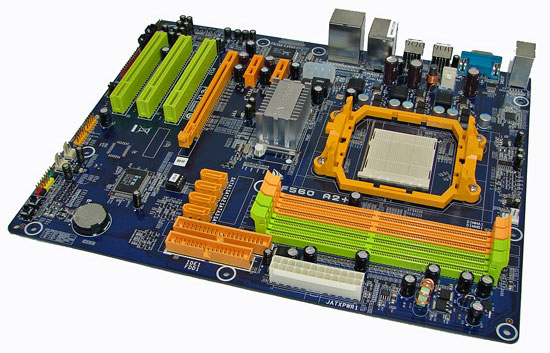
As far as the new performance oriented 0801 BIOS goes, there are not any additional settings when compared to the 0612 BIOS utilized in our preview article. In fact, in early testing we have not found any substantial performance improvements but we have been able to run lower voltages at the same settings and have finally broke the 355 HTT barrier.
Truly, what we found to be most impressive at this time is the ability of our $65 X2 65W 3800+ or $84 X2 45W BE2300 to easily reach 3.0GHz. While it's not always as fast as the top of the line X2 6000+ due to its only having half the L2 cache (and some other minor differences), our two budget AM2 processors certainly come close enough that we would not hesitate to spend our money on buying either CPU and this board if you're willing to overclock. That might allow the use of the extra funds for the purchase of a top tier graphics card.
As for the competition between the budget AMD and Intel processors, it's amazing how evenly matched they are. Top clocks are similar, performance is similar, and only cost is really different. If you want maximum performance, one of the better Core 2 chips will invariably win out, but for good performance on the cheap AM2 still has some life left in it.







